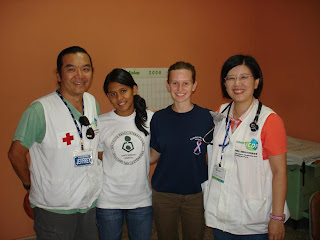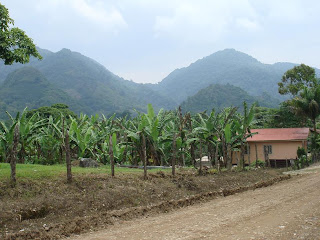After just three weeks in site I already felt like I needed a break (is that a good or a bad sign?). Well, good or bad I sure did enjoy the vacation. A bunch of other Peace Corps volunteers and I went up to La Ceiba, a large city on the north coast for Carnival and it was awesome. It was a very different Honduras than I have become accustomed to. First, it is right on the ocean, which I haven’t seen for a long time (and really miss). Second, it is much more ethnically diverse due to the Garifuna (African descendents). Third, it is a lot bigger, more economically diverse and a lot more touristy. It was odd for me to see so many foreigners, especially hippy backpackers. Before I came to the Peace Corps I kinda thought of Peace Corps as an alternative slightly hippy thing to do, but as it turns out we volunteers are pretty clean cut, especially because it is important for us to look presentable for our work. So to see tourists with long dreads and tattered clothes and backpacks is pretty funny.

The first night we checked out the street carnival. Music, dancing and food lined the streets for blocks and blocks and went all night long. I even got to dance punta (traditional Garifuna dance) on stage! We finished off the night at a dance club and I was appalled that I had to pay 100 limpiras (~$5) cover to get in.
Saturday we left Honduras (figuratively) and went to La Quinta Real, an actual luxury hotel for lunch. Again I was appalled to have to pay 180 limpiras (~$9) for lunch. Then we took advantage of being white (I know that sounds really racist, but it is true) and swam in their pool until we got kicked out (which goes to show you that skin color isn’t everything). Then we went swimming in the ocean, although the beaches aren’t that nice and the water apparently isn’t that clean (the volunteer that lived there told us not to put our head under water). Nonetheless it felt great to be in the water, it is so warm!


In the afternoon we watched the parade for about 4 hours. Various school bands, horses, floats, beauty queens, dancers and musicians paraded down the streets surrounded by thousands of onlookers, including close to 20 Peace Corps volunteers and various other foreigners. It was great fun to watch buy completely disorganized. There were no ropes/barriers lining the streets, so when no floats were coming by people rushed the streets. Also, people from balconies were throwing money and beads (think Mardi Gras) down into the street (I was sure it would start a riot, but luckily things remained pretty safe). Again we spent the night dancing in the streets and didn’t go to bed until after sunrise.




We had planned to head back to our sites on Sunday but we got a call from the head of Safety and Security for Honduras saying there was a bus strike and we weren’t allowed to travel. So, we had to stay in La Ceiba for two more days, how horrible! So instead of getting up early we slept in and again left Honduras (figuratively) and went to Appleebees in the mall. Then we spent the rest of the day at the Rodeo, watching bull riding and checking out artesanias (crafts).

Monday we stayed in Honduras and went for a hike to a beautiful waterfall and went swimming in the river and jumped off the waterfall. The water was so crisp and amazing, I miss being able to swim every day and see the water wherever I am! I had been wondering where all these gorgeous places were that they show you in the guide books. All the picture in Lonely Planet are of beautiful waterfalls and pristine beaches and tropical forests…now I know, they are all on the north coast!

Tuesday we were told that it was okay to travel so I headed back to Santa Barbara, but when I got to the bus station it turns out the strike was still on. The issue is this…in Honduras a “bus terminal” is not what you think of a bus terminal is the US. In the US a bus terminal means a large building where many buses drop off and pick up and depending on the size of a city there will be just a few. In Honduras a bus terminal is where a certain bus happens to park to pick people up and there are upwards of a hundred “bus terminals” in a large city. So, in San Pedro Sula they built a gigantic bus terminal where they want all the bus companies to park to streamline the process and reduce bus traffic within the city. Well, the bus companies don’t want to move, so they are on strike. So this meant that we had to take another bus to another city and get off at our turnoff and hope to hitch-hike the rest of the way. Luckily there was a taxi waiting at the turnoff so we didn’t have to jump in the back of a truck (I’m sure that will make my mother happy to hear). In the end I made it back to my site safely and it feels good to be ‘home’ again.

The first night we checked out the street carnival. Music, dancing and food lined the streets for blocks and blocks and went all night long. I even got to dance punta (traditional Garifuna dance) on stage! We finished off the night at a dance club and I was appalled that I had to pay 100 limpiras (~$5) cover to get in.
Saturday we left Honduras (figuratively) and went to La Quinta Real, an actual luxury hotel for lunch. Again I was appalled to have to pay 180 limpiras (~$9) for lunch. Then we took advantage of being white (I know that sounds really racist, but it is true) and swam in their pool until we got kicked out (which goes to show you that skin color isn’t everything). Then we went swimming in the ocean, although the beaches aren’t that nice and the water apparently isn’t that clean (the volunteer that lived there told us not to put our head under water). Nonetheless it felt great to be in the water, it is so warm!


In the afternoon we watched the parade for about 4 hours. Various school bands, horses, floats, beauty queens, dancers and musicians paraded down the streets surrounded by thousands of onlookers, including close to 20 Peace Corps volunteers and various other foreigners. It was great fun to watch buy completely disorganized. There were no ropes/barriers lining the streets, so when no floats were coming by people rushed the streets. Also, people from balconies were throwing money and beads (think Mardi Gras) down into the street (I was sure it would start a riot, but luckily things remained pretty safe). Again we spent the night dancing in the streets and didn’t go to bed until after sunrise.




We had planned to head back to our sites on Sunday but we got a call from the head of Safety and Security for Honduras saying there was a bus strike and we weren’t allowed to travel. So, we had to stay in La Ceiba for two more days, how horrible! So instead of getting up early we slept in and again left Honduras (figuratively) and went to Appleebees in the mall. Then we spent the rest of the day at the Rodeo, watching bull riding and checking out artesanias (crafts).

Monday we stayed in Honduras and went for a hike to a beautiful waterfall and went swimming in the river and jumped off the waterfall. The water was so crisp and amazing, I miss being able to swim every day and see the water wherever I am! I had been wondering where all these gorgeous places were that they show you in the guide books. All the picture in Lonely Planet are of beautiful waterfalls and pristine beaches and tropical forests…now I know, they are all on the north coast!

Tuesday we were told that it was okay to travel so I headed back to Santa Barbara, but when I got to the bus station it turns out the strike was still on. The issue is this…in Honduras a “bus terminal” is not what you think of a bus terminal is the US. In the US a bus terminal means a large building where many buses drop off and pick up and depending on the size of a city there will be just a few. In Honduras a bus terminal is where a certain bus happens to park to pick people up and there are upwards of a hundred “bus terminals” in a large city. So, in San Pedro Sula they built a gigantic bus terminal where they want all the bus companies to park to streamline the process and reduce bus traffic within the city. Well, the bus companies don’t want to move, so they are on strike. So this meant that we had to take another bus to another city and get off at our turnoff and hope to hitch-hike the rest of the way. Luckily there was a taxi waiting at the turnoff so we didn’t have to jump in the back of a truck (I’m sure that will make my mother happy to hear). In the end I made it back to my site safely and it feels good to be ‘home’ again.






























